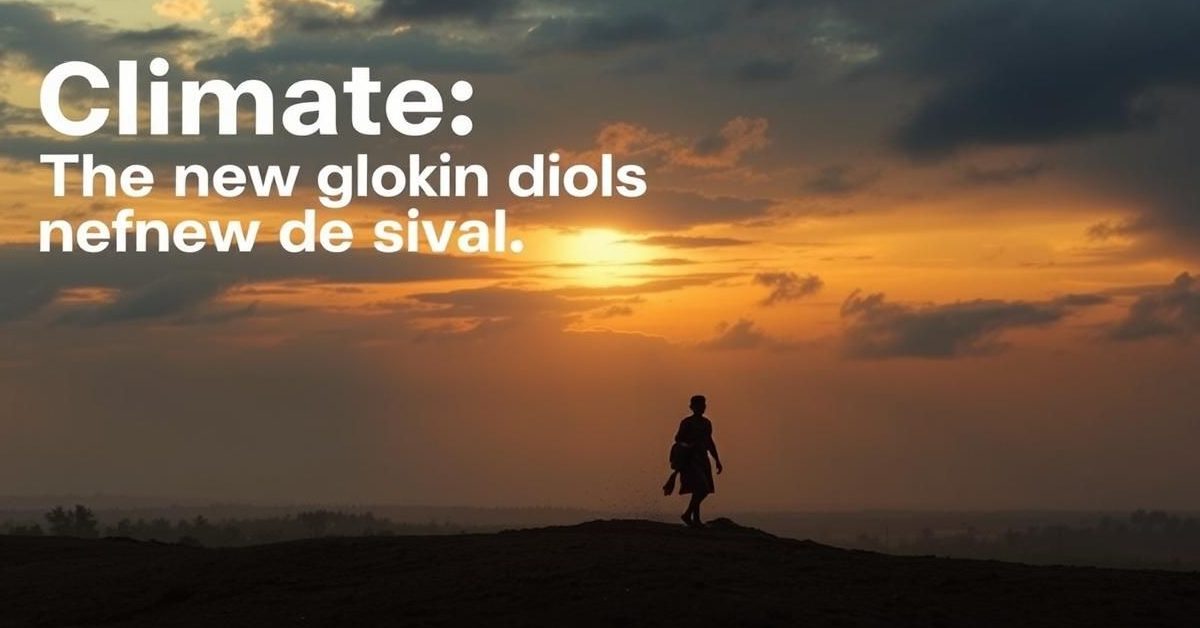While global attention focuses on conflicts, a quieter, escalating crisis sees millions displaced by climate change, yet largely unprotected by international law.
The Silent Crisis of Climate Displacement
Our planet is undergoing significant ecological changes, leading to an increasing number of people forced from their homes not by war, but by environmental collapse. In 2024 alone, the World Meteorological Organization reported over 600 extreme weather events, displacing more than 824,000 individuals.
Experts warn of severe risks like droughts, floods, and rising sea levels, compounded by population growth and resource scarcity. By 2050, it’s projected that 141 countries could face major natural disasters, potentially affecting 200 million people and triggering unprecedented global migration.
Defining “Climate Refugees”: A Complex Challenge
The term ‘climate refugees’ refers to people displaced by climate-induced ecological threats, but it lacks a universally agreed-upon definition. The UN High Commissioner for Refugees (UNHCR) prefers “persons displaced due to climate change and disasters” for its precision.
This ambiguity has led to various terms like ‘climate migrants’ or ‘disaster-displaced migrants.’ A key distinction for “climate refugees” often lies in cross-border migration, as many other displaced people remain within their own countries.
It’s also challenging to attribute displacement solely to climate factors, as environmental stressors often intertwine with poverty, governance issues, and conflict. This complexity makes it difficult to fit them into existing international protection frameworks.
A Legal Void: Why Protection is Lacking
Unlike traditional refugees fleeing persecution or conflict, climate-induced displacement doesn’t typically qualify for ‘refugee’ status under the 1951 Refugee Convention. This convention, and its 1967 protocol, do not recognize environmental causes as valid grounds.
A notable case in 2015 involved Ioane Teitiota from Kiribati, whose asylum application in New Zealand was rejected despite his homeland being threatened by rising sea levels. The court ruled that the convention requires a fear of persecution, which climate change doesn’t fulfill.
Adding to the complication, the affected states themselves are often victims of climate catastrophes, struggling to protect their populations due to depleted resources. The duration and nature of climate displacement can also vary widely, from temporary floods to permanent relocation, blurring the lines between forced and voluntary movement.
The Global South Bears the Brunt
Individuals displaced by environmental change disproportionately come from the Global South. These regions are often highly dependent on climate-sensitive agriculture and have limited capacity to adapt.
Examples include Central America’s Dry Corridor, where droughts and hurricanes have forced 1.4 million indigenous youth to seek aid, and the Sahel, where desertification and conflict have displaced over two million Burkinabé. Coastal Bangladesh faces an existential threat, with projections indicating 20 million people could be affected by rising sea levels by 2050.
While Teitiota’s appeal failed, a Tuvaluan family facing similar threats was granted residency in New Zealand on humanitarian grounds due to kinship ties, highlighting the current reliance on ad hoc solutions rather than formal legal frameworks.
“Soft Law” and Regional Efforts
In the absence of a binding international framework, “soft law” instruments have emerged. Initiatives like the Nansen Initiative (2012) and the Platform on Disaster Displacement (PDD) offer guidance but lack legal force, relying on voluntary state participation.
Global Compacts on Refugees (2018) and Migration (GCM) acknowledge climate change as a driver of displacement but remain non-binding. Regionally, the Kampala Convention in Africa addresses internal displacement from natural disasters, while Pacific Island frameworks promote sub-regional cooperation, though their scope is limited.
A significant 2020 UN Human Rights Committee ruling set a precedent by deeming it unlawful to return individuals to regions severely threatened by climate impacts, grounding its reasoning in the fundamental right to life. This signals potential avenues for integrating climate displacement into human rights frameworks.
Rethinking Climate Policy for a Human Future
There is an urgent need to recalibrate global climate policies, putting displacement at their core. Without this, solutions like sea walls might inadvertently lead to “climate gentrification,” displacing low-income communities as living costs rise.
Addressing this silent crisis requires a dual approach: upholding human rights while considering legitimate state security concerns. Crucially, the world must bridge the “triple gap” that defines the climate refugee dilemma: a conceptual gap in definition, a legal gap in recognition, and a policy gap in protection. Until then, millions will remain in a state of legal invisibility.
- Millions are being displaced globally by climate change, facing a quiet humanitarian crisis.
- The term “climate refugee” lacks a precise legal definition, complicating protection efforts.
- Existing international refugee laws do not recognize climate change as a basis for asylum.
- The Global South is disproportionately affected by climate-induced displacement.
- “Soft law” and regional initiatives offer some guidance but lack binding legal force.
- There’s an urgent need for new policies to define, recognize, and protect climate-displaced persons.















